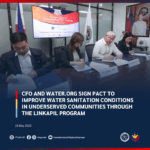GLIMPSES
A few years ago, in the course of regular visits to the United States in order to build support for the Gawad Kalinga movement there, I discovered a most beautiful secret. It’s not that there are four million Filipinos in America, or that they remit what must be around $8 billion to relatives in the Philippines, or that Filipino families are among the highest family earners, or that medical practitioners are a critical presence in their health care system – it is because of all of these and more.
Why is it a secret, then? Simple. They don’t know it and neither does anyone else.
What they know is what they earn, as individuals and as families, one by one. Perhaps, they had thought of themselves as apart from everyone else, not so much because they are selfish, but because life in America for migrants had been a constant struggle that allowed little collective opportunity after each working day. After all, a strong collective culture was not a defining virtue at all but rather a strong individual or family desire to survive and succeed in a foreign environment.
By the grace of God, and much human sacrifice, succeed they did. Of course, success came from individual or family effort as well. Naturally and consequently, the collective was not really a felt factor.
It did not mean, however, that serious effort was not exerted to bring Filipinos together in America. I know there have been thousands of Filipino-American clubs, groups and associations established, and I take this as an expression that individuals have tried to connect with others. While not pronounced as a factor of success in the careers or businesses of individuals and families, still and all, the need for togetherness eventually makes itself felt.
One of the most consistent efforts to be together have been made with doctors and other medical practitioners among Filipinos in their desire to hold medical and surgical missions to the Philippines. Each mission group may not be that large in numbers but it is more a group effort more than an individual one – even when some individuals may stand out as the driving force is some initiatives. I do not know of any other group of individuals with such defined persistence in offering their resources and services to help the poor in the motherland.
Except one, perhaps, and in a milder manner. I refer to hometown associations, Filipinos in America who come from the same hometown in the Philippines creating their groups so they can stay connected – mostly by being sponsors or donors of all sorts of hometown projects and causes.
But back to medical and surgical missions. It has never been a secret that health services for the poor in the Philippines had traditionally been from very little to none. There was a time, and not that long ago, when a substantial percentage of Filipinos would live and die without ever being to afford hospital care or even pharmaceutical medicine. This reality had never been lost among Filipino doctors and other medical practitioners in the United States, and never did they just try to turn a blind eye to this. Thus, the never-give-up medical and surgical missions to the Philippines.
Altruistic? Of course. Rewarding, too? Of course. Altruism and a sense of well-being and satisfaction are not mutually exclusive, especially when the latter simply follows as a consequence of the former. Spending their own resources aside from fund-raising from the medical and personal networks, scheduling their time off from work year after year, paying for their plane fares and their stay in the Philippines, usually from a few weeks to maybe two months, Filipino doctors and medical practitioners in America, with their non-Filipino guests, have always been the face of generosity and patriotism.
They have had to be very patient, too, and develop martyr-like attitudes in the course of their help missions. In stark contrast to the desire to help on their part had always been the rigid, suspicion-driven and often antagonistic attitude of government bureaucracy.
It has been a few years since I have written against the anti-Filipino posture of key government agencies and their leaderships. I thought I did monitor a sincere effort by the Department of Health (DOH) and the Commission of Filipino Overseas (CFO) to listen earnestly to the valid complaints of medical and surgical missions of Filipino doctors and medical practitioners from America. I thought, too, that I saw the beginnings of a new relationship borne from a new attitude of cooperation – from both sides.
At the same time, I also became aware of a rather substantial increase in the coverage of PhilHealth even among the very poor, that some program of subsidy was targeting this most needful sector. At the back of my mind, there have been very positive changes. In my heart, I simply wished the changes to continue.
It seems, though, that even positive changes may not be happening fast enough when it can. Lately, requests for assistance, basically to bring familiar concerns and frustrations to the urgent attention of the powers-that-be in key departments and even to the Office of the President, have been forwarded to me again. I am thinking out loud, now, how change can be such a struggle when the ills needing reform have been embedded in the system far too long.
But Filipino doctors, nurses and other medical practitioners in America must also realize that they have long had the power to make even the Philippine government sit up, listen and even cooperate. They just have to discover the secret they had long been blind to.
Become one. Lead the drive to bring enough Filipinos in America together to realize their own strength. You are not only remitting $8 billion annually, you are earning more than $200 billion annually, too. You have muscle but it is latent unless you develop a collective vision, and united effort.
As impossible a mission as the government efficiency you are looking for?
This article written by Jose Montelibano, one of the regular columnists for the MANILA-U.S. TIMES is worth posting on the MANILA-U.S. TIMES webpage. Please enjoy reading. Read through and accept the challenge in this article, a potent one.
Source:
Jose Ma Montelibano
Manila-US. Times
http://www.manila-ustimes.net/home/scalpels-with-a-heart/






